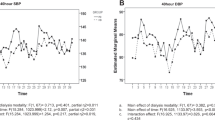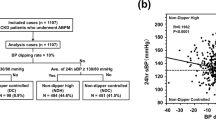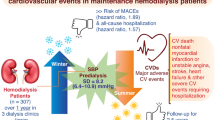Abstract
Management of hypertension is one of the fundamental interventions in dialysis patients. However, the profile of interdialytic blood pressure (BP) in Chinese dialysis patients remains elusive. We aim to investigate this issue as well as the effect of antihypertensive medication in this population. We performed 44-h ambulatory BP in 90 patients on maintenance hemodialysis. Patients were classified as ‘dipping’, ‘non-dipping’ or ‘reverse-dipping’ based on night/day ratio (N/D) of systolic BP on nondialysis day. The prevalence of blunted circadian BP pattern was strikingly high (92.2%), with more than half of the patients (55.6%) classified as reverse-dipping. There was a close association between high erythropoietin (EPO) dose used and deteriorated circadian rhythm. Patients in the dipping group also displayed a dipping state for heart rate (HR) compared with the other two groups (N/D of HR: 81.5±6.6 vs 92.1±6.0 and 91.3±10.7, P=0.02). Only 26.7% patients had a controlled nocturnal BP. Patients with bedtime dosing had lower N/D of systolic BP compared with patients without (100.1±7.0 vs 105.2±7.1, P=0.01). Non-dipping and reverse-dipping are highly prevalent in Chinese patients. EPO use and autonomic dysfunction may contribute to the blunted circadian rhythm. More tightly control of nighttime BP is an urgent need and bedtime dosing may be beneficial.
This is a preview of subscription content, access via your institution
Access options
Subscribe to this journal
Receive 12 digital issues and online access to articles
$119.00 per year
only $9.92 per issue
Buy this article
- Purchase on Springer Link
- Instant access to full article PDF
Prices may be subject to local taxes which are calculated during checkout


Similar content being viewed by others
References
Zoccali C, Mallamaci F, Tripepi G . Traditional and emerging cardiovascular risk factors in end-stage renal disease. Kidney Int Suppl 2003; 85: S105–S110.
Agarwal R . Epidemiology of interdialytic ambulatory hypertension and the role of volume excess. Am J Nephrol 2011; 34 (4): 381–390.
Agarwal R, Peixoto AJ, Santos SF, Zoccali C . Pre- and postdialysis blood pressures are imprecise estimates of interdialytic ambulatory blood pressure. Clin J Am Soc Nephrol 2006; 1 (3): 389–398.
Kelley K, Light RP, Agarwal R . Trended cosinor change model for analyzing hemodynamic rhythm patterns in hemodialysis patients. Hypertension 2007; 50 (1): 143–150.
Palatini P . Ambulatory blood pressure and cardiovascular risk in chronic kidney disease. Curr Hypertens Rep 2008; 10 (2): 119–126.
Amar J, Vernier I, Rossignol E, Bongard V, Arnaud C, Conte JJ et al. Nocturnal blood pressure and 24-hour pulse pressure are potent indicators of mortality in hemodialysis patients. Kidney Int 2000; 57 (6): 2485–2491.
Liu M, Takahashi H, Morita Y, Maruyama S, Mizuno M, Yuzawa Y et al. Non-dipping is a potent predictor of cardiovascular mortality and is associated with autonomic dysfunction in haemodialysis patients. Nephrol Dial Transplant 2003; 18 (3): 563–569.
Hermida RC, Ayala DE, Mojon A, Fernandez JR . Bedtime dosing of antihypertensive medications reduces cardiovascular risk in CKD. J Am Soc Nephrol 2011; 22 (12): 2313–2321.
K/DOQI Workgroup. K/DOQI clinical practice guidelines for cardiovascular disease in dialysis patients. Am J Kidney Dis 2005; 45 (4 Suppl 3): S1–153.
Fagugli RM, Quintaliani G, Pasini P, Ciao G, Cicconi B, Pasticci F et al. Blunted nocturnal blood pressure decrease and left-ventricular mass in hypertensive hemodialysis patients. Nephron 2002; 91 (1): 79–85.
Santos SF, Mendes RB, Santos CA, Dorigo D, Peixoto AJ . Profile of interdialytic blood pressure in hemodialysis patients. Am J Nephrol 2003; 23 (2): 96–105.
Mominadam S, Ozkahya M, Kayikcioglu M, Toz H, Asci G, Duman S et al. Interdialytic blood pressure obtained by ambulatory blood pressure measurement and left ventricular structure in hypertensive hemodialysis patients. Hemodial Int 2008; 12 (3): 322–327.
Tekce H, Kursat S, Bahadir Colak H, Aktas G . Effects of nutritional parameters on nocturnal blood pressure in patients undergoing hemodialysis. Ren Fail 2013; 35 (7): 946–950.
Verdecchia P, Angeli F, Gattobigio R, Guerrieri M, Benemio G, Porcellati C . Does the reduction in systolic blood pressure alone explain the regression of left ventricular hypertrophy? J Hum Hypertens 2004; 18 (Suppl 2): S23–S28.
Agarwal R . Blood pressure and mortality among hemodialysis patients. Hypertension 2010; 55 (3): 762–768.
Bonso E, Dorigatti F, Palatini P . Validation of Panasonic EW3106 and EW3109 devices for blood pressure measurement according to the International Protocol. Blood Press Monit 2010; 15 (1): 55–58.
Devereux RB, Alonso DR, Lutas EM, Gottlieb GJ, Campo E, Sachs I et al. Echocardiographic assessment of left ventricular hypertrophy: comparison to necropsy findings. Am J Cardiol 1986; 57 (6): 450–458.
Foley RN, Parfrey PS, Harnett JD, Kent GM, Murray DC, Barre PE . Impact of hypertension on cardiomyopathy, morbidity and mortality in end-stage renal disease. Kidney Int 1996; 49 (5): 1379–1385.
Agarwal R, Brim NJ, Mahenthiran J, Andersen MJ, Saha C . Out-of-hemodialysis-unit blood pressure is a superior determinant of left ventricular hypertrophy. Hypertension 2006; 47 (1): 62–68.
Cannella G, Paoletti E, Ravera G, Cassottana P, Araghi P, Mulas D et al. Inadequate diagnosis and therapy of arterial hypertension as causes of left ventricular hypertrophy in uremic dialysis patients. Kidney Int 2000; 58 (1): 260–268.
Fagugli RM, Ricciardi D, Rossi D, De Gaetano A, Taglioni C . Blood pressure assessment in haemodialysis patients: comparison between pre-dialysis blood pressure and ambulatory blood pressure measurement. Nephrology (Carlton) 2009; 14 (3): 283–290.
Goldsmith DJ, Covic AC, Venning MC, Ackrill P . Ambulatory blood pressure monitoring in renal dialysis and transplant patients. Am J Kidney Dis 1997; 29 (4): 593–600.
Hanly PJ, Pierratos A . Improvement of sleep apnea in patients with chronic renal failure who undergo nocturnal hemodialysis. N Engl J Med 2001; 344 (2): 102–107.
Zoccali C, Benedetto FA, Tripepi G, Cambareri F, Panuccio V, Candela V et al. Nocturnal hypoxemia, night-day arterial pressure changes and left ventricular geometry in dialysis patients. Kidney Int 1998; 53 (4): 1078–1084.
Agarwal R, Light RP . Arterial stiffness and interdialytic weight gain influence ambulatory blood pressure patterns in hemodialysis patients. Am J Physiol Renal Physiol 2008; 294 (2): F303–F308.
Agarwal R, Light RP . The effect of measuring ambulatory blood pressure on nighttime sleep and daytime activity-implications for dipping. Clin J Am Soc Nephrol 2010; 5 (2): 281–285.
Miyashita K, Tojo A, Kimura K, Goto A, Omata M, Nishiyama K et al. Blood pressure response to erythropoietin injection in hemodialysis and predialysis patients. Hypertens Res 2004; 27 (2): 79–84.
Canadian Erythropoietin Study Group. Effect of recombinant human erythropoietin therapy on blood pressure in hemodialysis patients. Am J Nephrol 1991; 11 (1): 23–26.
Erdogan D, Icli A, Aksoy F, Akcay S, Ozaydin M, Ersoy I et al. Relationships of different blood pressure categories to indices of inflammation and platelet activity in sustained hypertensive patients with uncontrolled office blood pressure. Chronobiol Int 2013; 30 (8): 973–980.
Kaya MG, Yarlioglues M, Gunebakmaz O, Gunturk E, Inanc T, Dogan A et al. Platelet activation and inflammatory response in patients with non-dipper hypertension. Atherosclerosis 2010; 209 (1): 278–282.
Hebert LA, Agarwal G, Ladson-Wofford SE, Reif M, Hiremath L, Carlton SG et al. Nocturnal blood pressure in treated hypertensive African Americans compared to treated hypertensive European Americans. J Am Soc Nephrol 1996; 7 (10): 2130–2134.
Sharma AP, Mohammed J, Thomas B, Lansdell N, Norozi K, Filler G . Nighttime blood pressure, systolic blood pressure variability, and left ventricular mass index in children with hypertension. Pediatr Nephrol 2013; 28 (8): 1275–1282.
Hoshide S, Kario K, Hoshide Y, Umeda Y, Hashimoto T, Kunii O et al. Associations between nondipping of nocturnal blood pressure decrease and cardiovascular target organ damage in strictly selected community-dwelling normotensives. Am J Hypertens 2003; 16 (6): 434–438.
Ben-Dov IZ, Kark JD, Ben-Ishay D, Mekler J, Ben-Arie L, Bursztyn M . Predictors of all-cause mortality in clinical ambulatory monitoring: unique aspects of blood pressure during sleep. Hypertension 2007; 49 (6): 1235–1241.
Agarwal R, Andersen MJ . Prognostic importance of ambulatory blood pressure recordings in patients with chronic kidney disease. Kidney Int 2006; 69 (7): 1175–1180.
Chaudhuri A, Sutherland SM, Begin B, Salsbery K, McCabe L, Potter D et al. Role of twenty-four-hour ambulatory blood pressure monitoring in children on dialysis. Clin J Am Soc Nephrol 2011; 6 (4): 870–876.
Tripepi G, Fagugli RM, Dattolo P, Parlongo G, Mallamaci F, Buoncristiani U et al. Prognostic value of 24-hour ambulatory blood pressure monitoring and of night/day ratio in nondiabetic, cardiovascular events-free hemodialysis patients. Kidney Int 2005; 68 (3): 1294–1302.
Acknowledgements
We thank Dr Juan Xu, Dr Yinmei L and Ms Sumin Cui for assistance in this study. This work was supported by the Foundation for Science and Technology Program in Health of Jiangsu to JY.
Author information
Authors and Affiliations
Corresponding author
Ethics declarations
Competing interests
The authors declare no conflict of interest.
Rights and permissions
About this article
Cite this article
Liu, W., Ye, H., Tang, B. et al. Profile of interdialytic ambulatory blood pressure in a cohort of Chinese patients. J Hum Hypertens 28, 677–683 (2014). https://doi.org/10.1038/jhh.2014.41
Received:
Revised:
Accepted:
Published:
Issue Date:
DOI: https://doi.org/10.1038/jhh.2014.41
This article is cited by
-
Time of hemodialysis and risk of intradialytic hypotension and intradialytic hypertension in maintenance hemodialysis
Journal of Human Hypertension (2023)
-
Night-time blood pressure and pulse wave velocity in dialysis patients
Clinical and Experimental Nephrology (2018)



